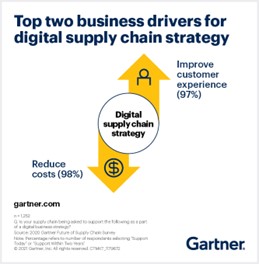Build an agile and resilient strategy for your retail supply chain
What is an agile supply chain?
Consumer preferences and behaviours are constantly changing. Suppliers may deliver late so stockouts occur. In the retail sector, agile means being able to adapt and respond quickly and effectively to fluctuations in consumer demand, changes in market conditions, and unexpected events. One of the top priorities for retailers now is to improve supply chain resilience and agility in meeting customer needs. This means having a high degree of flexibility and scalability. The challenge is to find the trade-offs between cost, speed, and service in an uncertain landscape. A recent Gartner survey found that nearly all respondents agree that they need to reduce costs while improving the customer experience.

Current trends in retail supply chains
IBM identified three main trends that will impact the success of retail supply chains in 2023: automation, hybrid retail and sustainability. Automation is one of the keys to creating a fully agile and future-proof supply chain. “….hybrid retail, is where consumers no longer see a distinct line between online and offline shopping experiences. They expect their shopping experiences to be seamlessly connected across platforms, online and off, 24/7”
Many consumers are open to paying more for products that are shown to be sustainable. They prioritise practices such as reducing waste, reusable eco-friendly packaging, and sourcing from ethical suppliers. IBM’s study found that purpose-driven consumers now represent the market’s single largest segment, eclipsing value-driven consumers who make purchasing decisions based on price. Retailers must become more aware of how important sustainability is to their customers.
The benefits of an agile supply chain
- Flexibility
Building supply chain resilience requires constant updating of processes and practices to cope with disruptions. Being flexible makes it easier to respond quickly to changing customer demands and market changes without interruption or delays. As new issues arise, companies need to adjust their plans to address the upcoming risks.
- Data visibility
Real-time online data provides visibility of all relevant information to all stakeholders. This supports effective demand planning, tracking, and decision-making. Insights provide ways to pinpoint bottlenecks and contain costs by addressing problems immediately.
- Business growth
Agile means improved quality, speedier delivery times, and control of costs leading to customer satisfaction. A more efficient supply chain means higher levels of growth and competitive advantage.
Challenges in achieving an agile supply chain.
Supply chains are becoming increasingly complex, making it difficult to monitor and manage each operation. Many retailers lack the necessary resources and expertise to create an agile retail supply chain. Implementing changes may require some investment in technology, automation, and personnel which can be a challenge, especially for smaller retailers. However, the benefits of embracing technology will pay dividends.
The power of technology
Cloud-based software can convert your data into information, making it available and transparent to all users. Available solutions use artificial intelligence (AI) machine learning, and data analytics to improve supply chain visibility, increase efficiency and enhance the customer experience. Users of the information can include internal staff, suppliers, contracted third parties, and customers. Sharing of reliable, real-time information through multiple communication channels delivers visibility that promotes faster-informed decisions. Visibility is the way to achieve true agility, by enabling businesses to spot problems before they occur. Increasing visibility and traceability can help you monitor and track your supply chain in real time, allowing you to take corrective action quickly and effectively.
How to create an agile retail supply chain
- Review your strategy and processes.
Understand your current supply chain and its weaknesses. Before making any changes, identify problems or challenges you need to address and the potential risks. With this information, create an action plan and make any obvious immediate improvements to improve performance.
- Upgrade your technology.
Leveraging data and analytics can help you identify potential risks and opportunities. The same data will assist you to develop strategies to mitigate the risks and capitalise on the opportunities. Access to real-time data allows you to respond quickly to unexpected changes. Invest in automating manual processes to increase visibility, optimise operations, and reduce costs. These actions can help you to improve the overall flow of information and create a more efficient and resilient retail supply chain.
- Build collaborative partnerships.
Establishing strategic relationships with suppliers and other stakeholders is another key to developing an agile supply chain. An internal team that includes store managers, IT professionals, planners, and warehouse supervisors working together will be able to identify problems and implement solutions. Understand the capabilities of your suppliers and encourage collaboration.
How agile is your supply chain? Agility relates to the ability to anticipate and bounce back from unexpected occurrences and those events that cause supply chain disruptions. To maintain a competitive advantage and continue to deliver on customer expectations, retailers need to embrace visibility, transparency, and automation. There are potential risks of implementing any change so strategies must be put in place to mitigate them.














